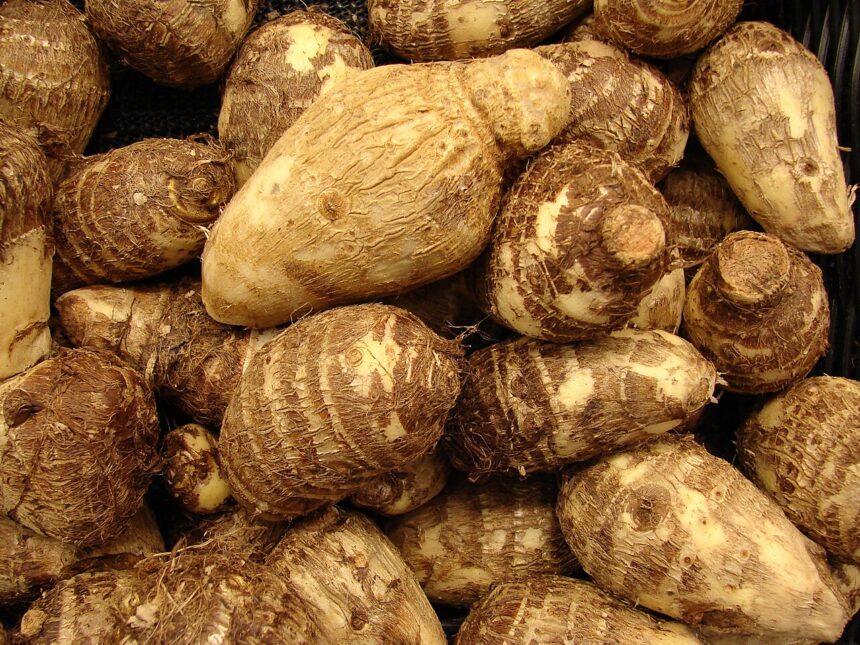Taro (Colocasia esculenta) is a tropical root vegetable known for its starchy corms. Growing taro in South Africa involves careful planning and management through all stages of cultivation. Here’s a detailed guide covering each growth stage, essential inputs, machinery requirements, pest and disease management, and storage practices.
1. Land Preparation
Soil Requirements:
- Type: Taro thrives in well-drained, loamy soils rich in organic matter. It can also grow in clayey soils but needs proper drainage.
- pH Level: The ideal pH range for taro is 5.5 to 7.0.
- Preparation: Clear the land of weeds, rocks, and debris. Plough the soil to a depth of 30 to 45 cm to ensure good root development. Incorporate organic matter, such as compost or well-rotted manure, to enhance soil fertility.
Machinery Needed:
- Tractor: For ploughing and soil preparation.
- Disc Harrow: To break up soil clumps and prepare a fine seedbed.
2. Seed Selection and Sowing
Seed Selection:
- Taro is typically propagated using corms or cormels, rather than seeds. Choose healthy, disease-free corms or cormels from a reputable source.
Sowing:
- Timing: Plant taro in the spring or early summer when temperatures are consistently warm (15-30°C).
- Spacing: Plant corms 15-20 cm apart in rows spaced 60-90 cm apart.
- Depth: Plant corms about 10-15 cm deep.
Inputs:
- Fertilizers: Incorporate a balanced fertilizer (NPK 10-10-10) into the soil before planting. During growth, side-dress with additional potassium and phosphorus as needed.
3. Growth Stages
Emergence:
- Timeline: Taro typically takes 2-3 weeks to emerge after planting.
- Care: Ensure adequate moisture and maintain a weed-free environment to support healthy growth.
Vegetative Growth:
- Watering: Taro requires consistently moist soil. Water the plants regularly, especially during dry periods. Avoid waterlogging.
- Fertilization: Apply a high-potassium fertilizer or liquid seaweed extract to promote vigorous growth.
Tuber Development:
- Monitoring: Taro corms start developing around 4-5 months after planting. Regularly check for signs of growth.
- Watering: Maintain even moisture levels to support tuber expansion.
Maturity:
- Timeline: Taro is usually ready for harvest 8-12 months after planting, depending on the variety and growing conditions.
- Harvest Indicators: Leaves will start to yellow, and the plant will begin to die back. Check the size of the corms before harvesting.
4. Harvesting
Method:
- Manual Harvesting: Use a fork or spade to carefully lift the corms from the soil without damaging them.
- Timing: Harvest before the first frost or when plants show signs of senescence.
Machinery:
- Harvesting Tools: Forks, spades, and gloves for manual harvesting.
5. Post-Harvest Handling and Storage
Cleaning:
- Remove excess soil and debris from the corms. Avoid washing them until ready for use to prevent spoilage.
Storage:
- Conditions: Store taro in a cool, dry place with good ventilation. Ideal storage conditions are 10-15°C with high humidity.
- Containers: Use breathable containers or bins to prevent mold growth.
6. Pest and Disease Management
Common Pests:
- Pest: Aphids, taro beetles, and nematodes.
- Management: Use insecticidal soap or neem oil for aphids. For beetles and nematodes, consider crop rotation or biological controls.
Common Diseases:
- Disease: Taro blight, root rot, and bacterial wilt.
- Management: Avoid waterlogging, use disease-resistant varieties, and apply appropriate fungicides if necessary.
Herbicides:
- Usage: Apply herbicides pre-emergence to control weeds. Post-emergence herbicides can be used carefully to avoid damaging the taro plants.
Pesticides:
- Usage: Use pesticides sparingly and according to label instructions to minimize environmental impact and resistance development.
7. Fertilization and Soil Management
Fertilizers:
- Use a balanced NPK fertilizer at planting and during growth. Supplement with potassium and phosphorus as needed.
Soil Management:
- Regularly monitor soil moisture and fertility. Add organic matter to maintain soil health and structure.
Growing taro in South Africa requires careful attention to soil preparation, planting, growth management, and pest control. By following these guidelines, South African farmers can optimize taro production, ensuring a healthy crop from seed to harvest and beyond. Proper land management, pest control, and post-harvest handling will help achieve a successful and profitable taro cultivation venture.
Join 'Farmers Mag' WhatsApp Channel
Get the latest Farming news and tips delivered straight to your WhatsApp
CLICK HERE TO JOIN






